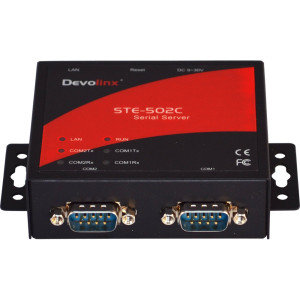Your shopping cart is empty!
MENU

Many businesses have substantial investments in equipment that lacks the ability to connect to a LAN or WAN. That makes remote access difficult or even impossible, preventing data acquisition, fault reporting and diagnosis, or control from off-site. Replacement may appear the only solution. But, there is a far less expensive option: the serial device server
Much legacy hardware used in applications like retail, manufacturing, medical and security was built with a serial port. Protocols like RS-232, RS-422 and RS-485 let equipment send and receive data through this port but don't support network access. A serial device server overcomes this problem by providing bi-directional data transfer between Ethernet and the serial port.
The minimum feature set includes a nine-pin DB9 type connector that accepts a serial cable, an RJ45 socket for Ethernet and firmware to handle the data format conversion. This in-built firmware, which gives the device server a configurable IP address, must be easy to set up and use and should be capable of updates if needed. It also ensures the device software is independent of the employed operating system or any proprietary protocols.
For long life and high reliability, buyers should also look for metal enclosures and ESD protection. DIN rail mounts simplify installation and are either standard or available as kit, depending on the model purchased.
Serial device servers made by Antaira Technologies and SENA incorporate all these key characteristics. All work with RS-232, RS-422, and RS-485 protocols and provide multiple configuration methods such as a built-in web server, Telnet, serial console, or a Windows-based utility.
The STE-501C industrial device server provides one Ethernet and one serial port, allowing for network connection of a single device. The STE-502C has two serial ports and the STE-6104C-T-V2 has four serial and two Ethernet ports. Doubling up on Ethernet ports enables daisy-chaining or can provide for redundant network connections. And, it can simplify cabling when multiple pieces of equipment are co-located but distant from a data capture system or process controller.
When more serial connections are needed the rack-mount NP3008T and NP3016T accept eight and 16 respectively. (Buyers must specify whether they need RS-232 or RS-422/485.) Designed for use in existing instrumentation racks, they need a 100 to 240 VAC power supply. The other device servers take 9 – 30 VDC.
Ethernet connectivity is taken for granted in the latest generations of manufacturing, security, medical, and security equipment, but is usually absent from older hardware. That prevents users from reaping the benefits of remote access, like remote management and the ability to retrieve and share test and process data.
Legacy equipment does, however, include a serial port offering bi-directional communication over RS-232, RS-422, or RS-485. Linking this port to a serial device server lets this equipment go on a network where a unique IP address enables access from any number of locations.
For further information about connecting your serial port-based equipment to Ethernet, contact your networking specialists at Westward Sales.